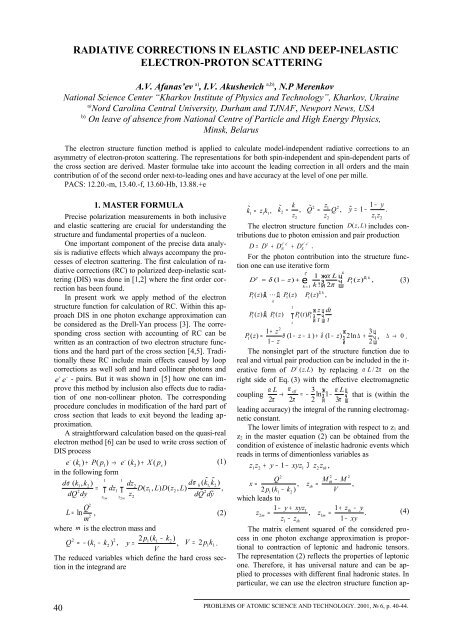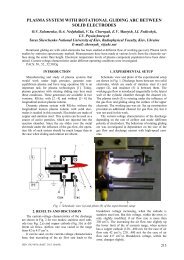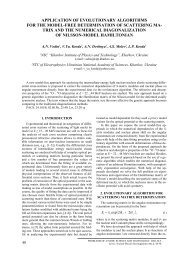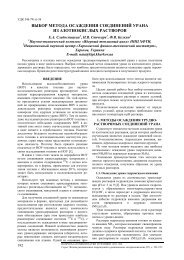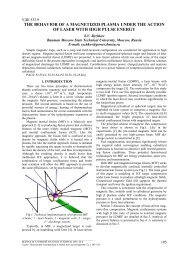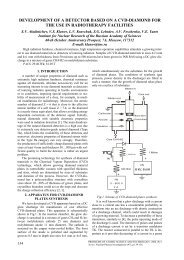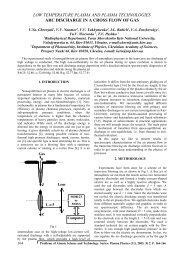RADIATIVE CORRECTIONS IN ELASTIC AND DEEP-INELASTIC ...
RADIATIVE CORRECTIONS IN ELASTIC AND DEEP-INELASTIC ...
RADIATIVE CORRECTIONS IN ELASTIC AND DEEP-INELASTIC ...
Create successful ePaper yourself
Turn your PDF publications into a flip-book with our unique Google optimized e-Paper software.
<strong>RADIATIVE</strong> <strong>CORRECTIONS</strong> <strong>IN</strong> <strong>ELASTIC</strong> <strong>AND</strong> <strong>DEEP</strong>-<strong>IN</strong><strong>ELASTIC</strong><br />
ELECTRON-PROTON SCATTER<strong>IN</strong>G<br />
A.V. Afanas’ev a) , I.V. Akushevich a,b) , N.P Merenkov<br />
National Science Center “Kharkov Institute of Physics and Technology”, Kharkov, Ukraine<br />
a)<br />
Nord Carolina Central University, Durham and TJNAF, Newport News, USA<br />
b)<br />
On leave of absence from National Centre of Particle and High Energy Physics,<br />
Minsk, Belarus<br />
The electron structure function method is applied to calculate model-independent radiative corrections to an<br />
asymmetry of electron-proton scattering. The representations for both spin-independent and spin-dependent parts of<br />
the cross section are derived. Master formulae take into account the leading correction in all orders and the main<br />
contribution of of the second order next-to-leading ones and have accuracy at the level of one per mille.<br />
PACS: 12.20.-m, 13.40.-f, 13.60-Hb, 13.88.+e<br />
1. MASTER FORMULA<br />
Precise polarization measurements in both inclusive<br />
and elastic scattering are crucial for understanding the<br />
structure and fundamental properties of a nucleon.<br />
One important component of the precise data analysis<br />
is radiative effects which always accompany the processes<br />
of electron scattering. The first calculation of radiative<br />
corrections (RC) to polarized deep-inelastic scattering<br />
(DIS) was done in [1,2] where the first order correction<br />
has been found.<br />
In present work we apply method of the electron<br />
structure function for calculation of RC. Within this approach<br />
DIS in one photon exchange approximation can<br />
be considered as the Drell-Yan process [3]. The corresponding<br />
cross section with accounting of RC can be<br />
written as an contraction of two electron structure functions<br />
and the hard part of the cross section [4,5]. Traditionally<br />
these RC include main effects caused by loop<br />
corrections as well soft and hard collinear photons and<br />
e + e<br />
− - pairs. But it was shown in [5] how one can improve<br />
this method by inclusion also effects due to radiation<br />
of one non-collinear photon. The corresponding<br />
procedure concludes in modification of the hard part of<br />
cross section that leads to exit beyond the leading approximation.<br />
A straightforward calculation based on the quasi-real<br />
electron method [6] can be used to write cross section of<br />
DIS process<br />
−<br />
−<br />
e ( k1 ) + P( p1<br />
) → e ( k2) + X ( p x<br />
)<br />
(1)<br />
in the following form<br />
1 1<br />
dσ<br />
( k1, k2 ) dz<br />
dσ<br />
(<br />
2<br />
h<br />
k% 1,<br />
k%<br />
2<br />
)<br />
= dz<br />
2 1<br />
D( z1, L) D( z2, L) ,<br />
2<br />
dQ dy<br />
т т<br />
z<br />
dQ% dy%<br />
2<br />
z1m<br />
z2m<br />
2<br />
L = ln Q , (2)<br />
2<br />
m<br />
where m is the electron mass and<br />
2 2 2 p1 ( k1 − k2<br />
)<br />
Q = − ( k1 − k2<br />
) , y = , V = 2 p1k1<br />
.<br />
V<br />
The reduced variables which define the hard cross section<br />
in the integrand are<br />
k<br />
k%<br />
= z k , k% 2 1 2<br />
= , Q = Q<br />
1 1 1 2<br />
z2<br />
z2<br />
%<br />
z<br />
,<br />
1 − y<br />
y%<br />
= 1 − .<br />
z z<br />
The electron structure function D( z, L) includes contributions<br />
due to photon emission and pair production<br />
+ − + −<br />
γ e e e e<br />
D = D + DN<br />
+ DS<br />
.<br />
For the photon contribution into the structure function<br />
one can use iterative form<br />
1 2<br />
е<br />
Ґ<br />
k<br />
1 жα<br />
L ц<br />
Д k<br />
1<br />
k = 1 k ! 2π<br />
(3)<br />
γ<br />
D = δ (1 − z) + з ч P ( z) ,<br />
и ш<br />
k<br />
P ( z) =Д L Д P ( z) P ( z) Д ,<br />
1 1 1<br />
k<br />
z dt<br />
P ( z) P ( z) P ( t)<br />
P ж ц<br />
=Д т з ч<br />
и t ш t<br />
1 1 1 1<br />
z<br />
1<br />
2<br />
1 + z<br />
3<br />
P1<br />
( z) (1 z ) (1 z) 2ln<br />
1 z θ<br />
δ ж ц<br />
= − − ∆ + − з ∆ + ч<br />
− и 2 ш , ∆ → 0 .<br />
The nonsinglet part of the structure function due to<br />
real and virtual pair production can be included in the iterative<br />
form of D ( z. L)<br />
by replacing α L / 2π on the<br />
γ<br />
right side of Eq. (3) with the effective electromagnetic<br />
α L α<br />
eff 3 α L<br />
coupling → = − ln ж 1<br />
ц<br />
2π 2π 2<br />
з −<br />
3π<br />
ч that is (within the<br />
и ш<br />
leading accuracy) the integral of the running electromagnetic<br />
constant.<br />
The lower limits of integration with respect to z 1 and<br />
z 2 in the master equation (2) can be obtained from the<br />
condition of existence of inelastic hadronic events which<br />
reads in terms of dimentionless variables as<br />
z1z2 + y − − xyz1 Ј z2<br />
z th<br />
1 ,<br />
2<br />
2 2<br />
Q<br />
M<br />
th<br />
− M<br />
x = , zth<br />
= ,<br />
2 p1 ( k1 − k2<br />
)<br />
V<br />
which leads to<br />
1 − y + xyz1<br />
1 + zth<br />
− y<br />
z2m<br />
= , z1m<br />
= . (4)<br />
z1<br />
− zth<br />
1 − xy<br />
The matrix element squared of the considered process<br />
in one photon exchange approximation is proportional<br />
to contraction of leptonic and hadronic tensors.<br />
The representation (2) reflects the properties of leptonic<br />
one. Therefore, it has universal nature and can be applied<br />
to processes with different final hadronic states. In<br />
particular, we can use the electron structure function ap-<br />
40<br />
PROBLEMS OF ATOMIC SCIENCE <strong>AND</strong> TECHNOLOGY. 2001, № 6, p. 40-44.
proach to compute RC to the elastic and deep-inelastic<br />
electron-proton scattering cross sections.<br />
On the other hand, the straightforward calculation in<br />
the first order with respect to α [1,2,6] and the recent<br />
calculation of the leptonic current tensor in the second<br />
order [7-10] for longitudinally polarized initial electron<br />
demonstrate that in the leading approximation spin-independent<br />
and spin-dependent parts of this tensor are the<br />
same for so-called nonsinglet channel contribution. The<br />
latter corresponds to photon radiation and e + e - -pairs production<br />
through single-photon mechanism. The difference<br />
appears in the second order due to possibility of<br />
pair production by double-photon mechanism [10].<br />
Therefore, the representation (2), being slightly modified,<br />
can be used for calculation of RC to cross sections<br />
of different processes with longitudinally polarized electron<br />
beam.<br />
In our recent work [11] we applied this method to<br />
compute RC to the ratio of the recoil proton polarizations<br />
measured in CEBAF Jefferson Lab [12], where the<br />
proton electric form factor G e was measured. In the<br />
present work we use the electron structure function<br />
method for calculation of model-independent part of RC<br />
to asymmetry in scattering of longitudinally polarized<br />
electrons on polarized protons at the level of per mile<br />
accuracy for elastic and deep-inelastic hadronic events.<br />
The cross section of the scattering of the longitudinally<br />
polarized electron by the proton with given longitudinal<br />
(l) or transverse (t) polarization for both elastic<br />
and deep-inelastic events can be written as a sum of its<br />
spin-independent and spin-dependent parts<br />
l,<br />
t<br />
dσ ( k1 , k2 , S) dσ ( k1, k2 ) dσ<br />
( k1, k2<br />
, S)<br />
= + η<br />
2 2 2<br />
, (5)<br />
dQ dy dQ dy dQ dy<br />
where S is 4-vector of the target proton polarization and<br />
η is the product of the electron and proton polarization<br />
degrees. Herein after we assume η = 1.<br />
The master equation (2) describes the RC to spin-independent<br />
part of the cross section on the right side of<br />
Eq. (5) and the corresponding equation for the spin-dependent<br />
part reads<br />
l,<br />
t<br />
dσ<br />
( k1, k2, S)<br />
2 =<br />
dQ dy<br />
1 1<br />
( p)<br />
1 2 1 2<br />
z1m<br />
z2m<br />
т dz т dz D ( z , L) D( z , L)<br />
ґ (6)<br />
l,<br />
t<br />
dσ hard<br />
( k% 1, k%<br />
2<br />
, S) 2 ,<br />
( p) e e e e ( p<br />
dQ% D D γ<br />
+ − + −<br />
= + D ) ,<br />
dy%<br />
N<br />
+ DS<br />
and [10]<br />
2 2<br />
+ −<br />
e e ( p)<br />
α L й 2(1 − z)<br />
щ<br />
DS<br />
= (1 z)ln z θ (1 z 2 m / ε )<br />
2<br />
4π<br />
к<br />
+ + − −<br />
л 2<br />
ъ<br />
.<br />
ы<br />
The representation (6) is valid if radiation of<br />
collinear particles does not lead to change polarization<br />
4-vectors. In general case it is not so [13] but in this paper<br />
we will use just such polarizations which satisfy this<br />
conditions (see next Section)<br />
The asymmetry in elastic scattering and DIS processes<br />
is defined as the ratio<br />
l,<br />
t<br />
l, t dσ<br />
( k1, k2<br />
, S) A =<br />
,<br />
dσ<br />
( k , k )<br />
1 2<br />
therefore, RC to asymmetry requires the knowledge of<br />
RC to both spin-independent and spin-dependent parts.<br />
2. THE LEAD<strong>IN</strong>G APPROXIMATION<br />
Within the leading accuracy (taking into account<br />
terms of the order (αL) n ) the electron structure functions<br />
can be computed in all orders of the perturbation theory.<br />
In this approximation we have to take the Born cross<br />
section as hard part in integrands of master Eqs. (2), (6).<br />
We express the Born cross section in terms of leptonic<br />
and hadronic tensors as follows<br />
2 2<br />
dσ<br />
4 π α ( Q ) B<br />
2 4 L<br />
µ ν H<br />
µ ν<br />
= ,<br />
(7)<br />
dQ dy VQ<br />
where α(Q 2 ) is the runing electromagnetic constant that<br />
takes into account for the effects of vacuum polarization<br />
and<br />
F M Sq<br />
H = − F g% + p% p%<br />
− iε<br />
q [( g + g ) S − g ],<br />
p q p q p q<br />
2<br />
µ ν 1 µ ν 1µ 1ν µ ν λ ρ λ<br />
1 2 2<br />
1 1 1<br />
Q<br />
L g k k k k i q p<br />
2<br />
2<br />
B<br />
µ ν<br />
= − %<br />
µ ν<br />
+<br />
1µ 2ν +<br />
1ν 2 µ<br />
+ ε<br />
µ ν λ ρ λ 1 ρ<br />
,<br />
qµ qν<br />
p1q<br />
g% µ ν<br />
= gµ ν<br />
− , p% 2 1µ = p1<br />
µ<br />
− .<br />
2<br />
(8)<br />
q<br />
q<br />
In Eqs. (8) we assume the proton and electron polarization<br />
degrees equal to unity. The proton structure functions<br />
F 1, F 2 and g 1, g 2 depends on variables x′=-q 2 /2p 1q,<br />
q 2 =(p x-p) 2 . In Born approximation, x′ =x but they differ<br />
in general case, when radiation of photons and electronpositron<br />
pairs are allowed.<br />
It is convenient to express the 4-vector of proton polarization<br />
in terms of 4-momenta of particles in process<br />
up + Vk − [2 uτ<br />
+ V (1 − y)]<br />
k<br />
t<br />
Sµ<br />
=<br />
2 2 2<br />
− uV (1 − y)<br />
− u M<br />
1µ 2 µ 1µ<br />
2 2<br />
2M k<br />
l 1µ − Vp1 µ<br />
2 M<br />
Sµ = , u = − Q , τ = .<br />
MV<br />
V<br />
,<br />
(9)<br />
As normalization is chosen, the elastic limit can be<br />
reached by a simple substitution in hadronic tensor<br />
G + λ G<br />
F x G F x<br />
2 1 + λ<br />
2 2<br />
1 2<br />
1 (1 ) ,<br />
2 (1 )<br />
e m<br />
→ δ − ў<br />
m<br />
→ δ − ў ,<br />
1 й ( G )<br />
1 (1 )<br />
m<br />
Ge Gm<br />
g x GmG λ −<br />
щ<br />
→ δ − ў<br />
e<br />
2 к<br />
+<br />
1 + λ ъ<br />
л ы ,<br />
2<br />
1 λ ( G )<br />
g1<br />
→ − δ (1 − xў<br />
)<br />
m<br />
− Ge Gm<br />
, q<br />
λ = −<br />
2<br />
2<br />
1 + λ<br />
4M<br />
,<br />
where G m and G e are magnetic and electric proton formfactors<br />
which depend on q 2 .<br />
A simple calculation gives the spin-independent and<br />
spin-dependent parts of the cross section in the form<br />
B<br />
2 2<br />
dσ<br />
4 π α ( Q ) 2<br />
=<br />
2 4 [(1 − y − xyτ<br />
) F2 + xy F1<br />
] , (10)<br />
dQ dy Q y<br />
41
B<br />
2 2<br />
dσ l 8 π α ( Q ) йж<br />
2 − y ц 2τ<br />
щ<br />
=<br />
2 2 к з τ − ч g<br />
1<br />
+ g<br />
2 ъ<br />
dQ dy V y ли<br />
2xy<br />
ш y<br />
, (11)<br />
ы<br />
dσ<br />
Q M<br />
dQ dy V y Q<br />
(12)<br />
B<br />
2 2 2<br />
t 8 π α ( ) ж 2<br />
= − (1 − y − xyτ<br />
) g<br />
2 2 2<br />
1<br />
+ g2<br />
ц<br />
з<br />
y<br />
ч ,<br />
и ш<br />
Thus, within the leading accuracy, the radiatively corrected<br />
cross section of the process (1) is defined by<br />
Eq. (2) for its spin-independent piece with (10) as a hard<br />
cross section into integrand and by Eq. (6) with (11) or<br />
(12) as the hard part for its spin-dependent piece.<br />
It is useful to extract the leading first order correction<br />
to the Born approximation as defined by master<br />
Eqs. (2), (6). For this purpose we can use the structure<br />
function D γ with L → L − 1 and<br />
2( ∆ ε )<br />
∆ → ∆<br />
1<br />
= τ + z+ , z+<br />
= y(1 − x),<br />
V (1 − xy)<br />
for D(z 1,L) and<br />
2( ∆ ε )<br />
2( ∆ ε )<br />
∆ → ∆<br />
2<br />
= τ + z+<br />
,
Pˆ<br />
f ( r, xў) = f ( r , x ), Pˆ<br />
f ( r, xў) = f ( r , x ),<br />
t 1 t s 2 s<br />
xyr<br />
xyr<br />
xt<br />
= , x = .<br />
xyr z xyr z<br />
1 2<br />
s<br />
1<br />
+<br />
2<br />
+<br />
Note that quantity r 1(r 2) coinsides with z 1(1/z 2) for radiation<br />
of a single collinear photon. The hard cross section<br />
(14) has neither collinear nor infrared singularities. The<br />
different terms on the right-hand side of Eq. (14) have<br />
singularities at r=r 1, r=r 2 and γ=1. Singularities at first<br />
two points are collinear and at third one is unphysical<br />
that arise at integration. Collinear singulariries vanish<br />
due to action of operators P<br />
ˆt<br />
and P ˆs on the terms containing<br />
N. The unphysical singulariry cancels because in<br />
the limiting case r → 1 we have<br />
r2 − r r1<br />
− r<br />
= 1, = − 1, Tt<br />
+ Ts<br />
= 0.<br />
| r − r | | r − r |<br />
2 1<br />
The corresponding result for spin-dependent hard<br />
cross section can be written by very similar form<br />
l,<br />
t<br />
B<br />
z+<br />
dσ dσ<br />
hard<br />
l, t ж α ц α l, t м 1 − r1<br />
ˆ l,<br />
t<br />
= 1 U dz P<br />
2 2 з + δ ч + 2<br />
4<br />
н<br />
t<br />
Nt<br />
dQ dy dQ dy π Q<br />
т<br />
и ш о 1 − xy<br />
1 −<br />
−<br />
1 −<br />
r2<br />
P ˆ l,<br />
t<br />
s N<br />
s<br />
z +<br />
+<br />
+<br />
r<br />
т<br />
r−<br />
dr<br />
l,<br />
t<br />
2W<br />
+<br />
2<br />
y + 4xyτ<br />
dr й 1 − P ж 2( r − r)<br />
ц<br />
Ρ + + ч −<br />
л и ш<br />
+<br />
s<br />
2 l, t 2 l,<br />
t<br />
т<br />
з (1 r ) N<br />
s<br />
Ts<br />
1 − r<br />
к<br />
| r − r2 | (1 − z )<br />
r<br />
r− +<br />
2<br />
1 − Pˆ<br />
t<br />
ж (1 + r ) N<br />
з<br />
| r − r1<br />
| и 1 − xy<br />
where<br />
2 l,<br />
t<br />
t<br />
+<br />
zth<br />
2 2<br />
l,<br />
t<br />
1<br />
− r Tt<br />
3<br />
2 r( r )<br />
x αў<br />
ы<br />
) щ}<br />
1 2<br />
1 2<br />
( rQ )<br />
, (15)<br />
r<br />
2<br />
l t M<br />
− 1 l<br />
U = 1, U = (1 − y − xyτ<br />
) , W = 4 yτ<br />
W,<br />
2<br />
Q<br />
t 2<br />
W = 2 y (1 + 2 xτ<br />
) W, W = (1 + r) xg1 + x g2<br />
,<br />
l<br />
N = 2[2 r − z − xy( r + 2 τ )] g − 8 xўτ<br />
g ,<br />
t<br />
l<br />
N = 2[2 − z − xyr(1 + 2 τ ) g − 8 xўτ<br />
g ,<br />
s<br />
t<br />
N = 2[1 − y − z + r − xy( r + 2 τ )]( xyg + 2 xўg<br />
),<br />
t<br />
1 2<br />
t й<br />
1 − z щ<br />
Ns<br />
= 2<br />
к<br />
1 − y − xy(1 + 2 τ ) + ( xyrg1 + 2 xўg<br />
2<br />
),<br />
л<br />
r ъ<br />
ы<br />
Tt l = 2rg1 − 4x ′ τ g2, Ts l = 2( z − 1)( g1 − 2x ′ τ g2<br />
),<br />
t<br />
T = 2xyrg + 2 xў(1 − y + r − 2 xyτ<br />
) g ,<br />
t<br />
1 2<br />
t<br />
й<br />
ж 1<br />
ц щ<br />
Ts<br />
= 2( z − 1) к xyg1 + xўз<br />
1 − y + − 2 xyτ<br />
ч g2<br />
.<br />
r<br />
ъ<br />
л<br />
и<br />
ш ы<br />
The polarized hard cross section (15) as well is free<br />
from any singularities. Note that radiation of photon at<br />
large angles by the initial and final electrons increases<br />
the region of variation for quantity r in (14) and (15),<br />
because for collinear radiation r 1 < r < r 2 and now we<br />
have r - < r 1 and r + > r 2. It may be important if the hadron<br />
structure functions are large in these additional regions.<br />
ў<br />
The function δ ( 1 − x ′ ) is used to perform the integration<br />
with respect to inelasticity z .<br />
The final result for unpolarized case has the following<br />
form (we do not introduce special notation for the<br />
elastic cross-section)<br />
B<br />
dσ hard dσ ж α ц α м 1 − r1 ˆ<br />
1 − r2<br />
= 1 P ˆ<br />
2 2 з + δ ч + 2<br />
2 н t N − Ps<br />
N<br />
dQ dy dQ dy и π ш V о 1 − xy 1 − z+<br />
+<br />
r<br />
r+<br />
ˆ<br />
2<br />
2 W dr й 1 − Pt<br />
(1 + r ) N<br />
+ т dr<br />
+ Ρ ( ( r1<br />
2<br />
т к<br />
+<br />
4 1 r | r r1<br />
| 1 xy<br />
r y + xyτ<br />
− − −<br />
−<br />
r−<br />
л<br />
2 2 2<br />
1 − Pˆ<br />
s<br />
ж (1 + r ) N ц щьп<br />
α ( rQ )<br />
− r) Tt<br />
) − з + ( r2<br />
− r) Ts<br />
ч ъ э ,<br />
| r − r2<br />
| и 1 − z+<br />
шыюп<br />
r<br />
where<br />
2 2<br />
2 2(1 − y − xyτ<br />
)( Ge<br />
+ λ Gm<br />
)<br />
N = Gm<br />
+<br />
2 2<br />
,<br />
x y r(1 + λ )<br />
T<br />
t<br />
=<br />
2 2<br />
2[ r(1 − y) − 1]( Ge<br />
+ λ Gm<br />
)<br />
2 2<br />
,<br />
x y r(1 + λ )<br />
(16)<br />
2 2 2 2<br />
2[ r + y − 1]( Ge + λ Gm ) 2 2 τ ( Ge + λ Gm<br />
)<br />
Ts<br />
= , W = G<br />
.<br />
2 2<br />
m<br />
−<br />
x y r(1 + λ )<br />
xyλ<br />
(1 + λ )<br />
The Born cross section on the right-hand side of<br />
Eq. (16) is defined as<br />
B<br />
2 2<br />
dσ<br />
2 π α ( Q )<br />
= ґ<br />
2 2<br />
dQ dy V<br />
2 2 2<br />
й<br />
2 2[1 − y(1 + τ )]( Ge<br />
+ λ Gm<br />
щ ж Q ц<br />
кGm<br />
+ δ y .<br />
2<br />
ъ з − ч<br />
л<br />
y (1 + λ )<br />
ы и V ш<br />
When writing this last equation we take into account that<br />
δ(1-x)=yδ(1-Q 2 /V).<br />
The spin-dependent hard cross section for elastic<br />
hadronic events can be written in the very similar to (16)<br />
form<br />
l,<br />
t<br />
B<br />
dσ dσ<br />
hard<br />
l, t ж α ц α l, t 1 − r1<br />
ˆ l,<br />
t<br />
= 1 U { P<br />
2 2 з + δ ч +<br />
t<br />
Nt<br />
+<br />
dQ dy dQ dy и 2 π ш V 1 − xy<br />
1 −<br />
1 − Pˆ<br />
t<br />
+ + Ρ [ − ґ<br />
1 − z 1 − r | r − r |<br />
ж<br />
з<br />
и<br />
+<br />
r<br />
l,<br />
t<br />
r+<br />
r2<br />
ˆ l,<br />
t W dr<br />
Ps<br />
N<br />
s т dr<br />
2<br />
т<br />
+<br />
r y + 4xyτ<br />
−<br />
r−<br />
+ r N ц<br />
− ˆ<br />
s<br />
+ − + P ґ<br />
1 − xy ш | r − r | (1 − z +<br />
)<br />
(1<br />
2 l,<br />
t<br />
)<br />
t<br />
l,<br />
t<br />
2 r( r1<br />
r)<br />
Tt<br />
ч<br />
1<br />
2<br />
2 2<br />
ж 2 l, t 2( r2<br />
− r) l,<br />
t ц α ( rQ )<br />
з (1 + r ) N<br />
s<br />
+ Ts<br />
ч]}<br />
,<br />
2 2 2<br />
и<br />
r2<br />
ш (4 M + Q r)<br />
r<br />
l<br />
t 2<br />
W = 4 yτ<br />
W , W = 2 y (1 + 2 xτ<br />
) W,<br />
й 4τ<br />
щ<br />
W = r x + r − G + к r + + r G G<br />
y<br />
ъ<br />
л<br />
ы<br />
2<br />
[ (1 ) 1]<br />
m<br />
(1 )<br />
m e<br />
,<br />
й<br />
ж 2 ц щ<br />
T r к r G з ч G G ъ<br />
л<br />
и xy ш ы<br />
l<br />
2<br />
t<br />
= ( + 2 τ )<br />
m<br />
+ 2τ<br />
− 1<br />
m e<br />
,<br />
1<br />
4. HARD CROSS SECTION<br />
FOR <strong>ELASTIC</strong> HADRONIC EVENTS<br />
To describe the hard cross section for elastic hadronic<br />
events we use the replacement given after formulae<br />
(9) in expressions (14) and (15). For Born cross sections,<br />
which enter in these equations, see Eqs. (10-12).<br />
43
l<br />
2 ж 2 ц<br />
t<br />
Ts = − r(1 + 2 τ ) Gm − 2 τ з − r ч GmGe , Tt<br />
= r{ − [ r(1 − xy)<br />
+<br />
и xy ш<br />
1<br />
− y − xy G + − y − xy + r + G G T = r − r<br />
2<br />
t<br />
1 2 τ )]<br />
m<br />
(1 2 τ 4 τ )<br />
m e}, s<br />
[<br />
xy y G xyr r y G G<br />
2<br />
(1 + 2 τ ) + 1 − ]<br />
m<br />
− [2 τ (2 − ) + 1 + (1 − )]<br />
m e,<br />
й 1 − xy щ<br />
N r r xy G к r G G<br />
xy<br />
ъ<br />
л<br />
ы<br />
l<br />
2<br />
t<br />
= (2 τ + )(2 − )<br />
m<br />
+ 8 τ − τ<br />
m e,<br />
l<br />
N = r(2τ<br />
+ 1)(2 − xyr)<br />
G<br />
s<br />
2<br />
m<br />
2<br />
[2 r(1 + 2 τ ) GmGe − r(2 − xyr) Gm<br />
].<br />
й 1<br />
щ<br />
+ 8 τ к r(1 + τ ) GmGe<br />
,<br />
xy<br />
ъ<br />
л<br />
ы<br />
t<br />
N = [1 − y + r − xy( r + 2 τ )][2( r + 2 τ ) G G −<br />
t m e<br />
2 t 1<br />
r(2 − xy) Gm<br />
, Nt<br />
= [1 − y + − xy(1 + 2 τ )] ґ<br />
r<br />
Note that argument of electromagnetic formfactors in<br />
2<br />
Eqs. (15) and (16) is − Q r .<br />
The Born cross sections on the right-hand side of<br />
Eq. (16) have the following form<br />
B<br />
2 2<br />
dσ<br />
l 4 π α ( Q ) й ж 1 ц<br />
= 4 1 (1 2 )<br />
2 2 2 к τ + τ − Gm<br />
Ge<br />
− + τ<br />
dQ dy V(4 M + Q )<br />
з<br />
y<br />
ч<br />
л и ш<br />
2<br />
ж y ц 2 щ ж Q ц<br />
−ґ з 1 G 2<br />
ч m ъ δ −з y<br />
V<br />
ч<br />
и ш ы и ш<br />
for longitudinally polarized of the target proton and<br />
B<br />
2 2 2<br />
dσ<br />
t 8 π α ( Q ) M<br />
= [1 − y(1 + τ )] ґ<br />
2 2 2 2<br />
dQ dy V (4 M + Q ) Q<br />
2<br />
йж<br />
y ц 2<br />
щ ж Q ц<br />
к з 1 − ч Gm − (1 + 2 τ ) GmGe<br />
δ з y − ч ,<br />
2<br />
ъ<br />
л и ш<br />
ы и V ш<br />
for transverse one. The argument of form factors in the<br />
last two formulae is –Q 2 .<br />
In this paper we consider model-independent QED<br />
radiative correction to the polarized DIS and elastic<br />
electron-proton scattering. Our calculations are based on<br />
the electron structure function method which allows to<br />
write both the spin-independent and spin-dependent<br />
parts of the cross section with accounting RC to the leptonic<br />
part of interaction in the form of well-known<br />
Drell-Yan representation. The corresponding RC includes<br />
explicitly the first order correction as well as the<br />
leading-log contribution in all orders of perturbation<br />
theory and the main part of the second order next to<br />
leading-log one. Moreover, any model-dependent RC to<br />
the hadronic part of interaction can be included in our<br />
analytical result by insertion it as an additive part of the<br />
hard cross section in integrand in master equations.<br />
To derive RC, we take into account radiation of photons<br />
and e + e - -pairs in collinear kinematics which produces<br />
a large logarithm L in the radiation probability (in<br />
D-functions) and radiation of one non-collinear photon<br />
that enlarges the limits of variation of the hadron structure<br />
function arguments. It may be important that these<br />
functions are sharp enough. In this case the loss in radiation<br />
probability (the loss of L) can be compensated by<br />
the increase in the value of the hard cross section.<br />
On the basis of our analytical result we constructed<br />
Fortran code ESFRAD (http://www.jlab.org/~aku/RC) and<br />
perform some numerical estimations [15] for kinematical<br />
conditions of current and future experiments. We<br />
found two regions where the higher order radiative corrections<br />
can be important. These are the traditional region<br />
of high y and the region around the pion threshold.<br />
REFERENCES<br />
1. T.V. Kukhto and N.M. Shumeiko. Radiative effects<br />
in deep inelastic scattering of polarized leptons<br />
by polarized nucleons // Nucl. Phys. 1983 v. B 219,<br />
p. 412-436.<br />
2. D.Y. Bardin and N.M. Shumeiko. On an exact<br />
calculation of the lowest-order electromagnetic correction<br />
to the point particle elastic scattering // Nucl.<br />
Phys. 1977 v. B 127, p. 242-258.<br />
3. S.D. Drell and T. Yan. Massive lepton-pair<br />
production in hadron-hadron collisions at high energies<br />
// Phys. Rev. Lett. 1970 v. 25, p. 316-319.<br />
4. E.A. Kuraev, V.S. Fadin. About radiative corrections<br />
to the cross section of one photon annihilation of<br />
+<br />
high energy e e −<br />
-pair // Yad. Fiz. 1985 v. 41, p.<br />
733-742.<br />
5. E.A. Kuraev, N.P. Merenkov, V.S. Fadin.<br />
Calculation of radiative corrections to electron-nucleus<br />
scattering by the structure function method //<br />
Yad.Fiz. 1988 v. 47, p. 1593-1601.<br />
6. V.N. Baier, V.S. Fadin, V.A. Khoze. Quasireal<br />
electron methopd in high energy quantum electrodynamics<br />
// Nucl. Phys. 1973, v. B 65, p. 381-396.<br />
7. I. Akushevich, A.B. Arbuzov, E.A. Kuraev.<br />
Compton tensor with heavy photon in the case of longitudinally<br />
polarized fermion // Phys. Lett. 1998, v. B<br />
432, p. 222-229.<br />
8. G.I. Gakh, M.I. Konchatnij, N.P. Merenkov.<br />
Compton tensor with heavy photon for longitudinally<br />
polarized electron with next-to-leading accuracy<br />
// Pis’ma Zh. Eksp. Teor. Fiz. 2000 v. 71,<br />
p. 328-332.<br />
9. M.I. Konchatnij, N.P. Merenkov. Current tensor<br />
with heavy photon for double hard photon<br />
emission by longitudinally polarized electron //<br />
Pis’ma Zh. Eksp. Teor. Fiz. 1999 v. 69, p. 845-890.<br />
10. M.I. Konchatnij, N.P. Merenkov,<br />
O.N. Shekhov-tsova. Current tensor with heahy<br />
photon for hard pair production by longitudinally<br />
polarized electrons // Zh. Eksp. Teor. Fiz. 2000<br />
v. 118, p. 5-19.<br />
11. A.V. Afanas’ev, I. Akushevich, N.P. Merenkov.<br />
Radiative correction to the transferred polarization in<br />
elastic electron-proton scattering // Phys. Rev. D. 2002,<br />
v. 65, 013006.<br />
12. M.K. Jones, K.A. Aniol, F.T. Baker et al.<br />
GE<br />
/ G<br />
p M p Ratio by Polarization Transfer in<br />
r r<br />
ep → ep // Phys. Rev. Lett. 2000, v. 84, p. 1398-<br />
1402.<br />
13. A.V. Afanas’ev, I. Akushevich, G.I. Gakh,<br />
N.P. Merenkov. Radiative Corrections to Polarized<br />
Inelastic Scattering in the Coincidence Setup //<br />
Zh. Eksp. Teor. Fiz. 2001, v. 120, p. 515-528.<br />
14. E.A. Kuraev, N.P. Merenkov, V,S. Fadin.<br />
Compton-effect tensor with heavy photon // Yad.<br />
Fiz. v. 45, p. 782-789.<br />
ВОПРОСЫ АТОМНОЙ НАУКИ И ТЕХНИКИ. 2000, №2.<br />
Серия: Ядерно-физические исследования (36), с. 3-6.<br />
44
45<br />
15. A.V. Afanas’ev, I. Akushevich,<br />
N.P. Merenkov. QED correction to asymmetry for<br />
polarized ep -scattering from the method of the<br />
electron structure functions // hep-ph/0111331<br />
(submitted to Phys. Rev. D).


